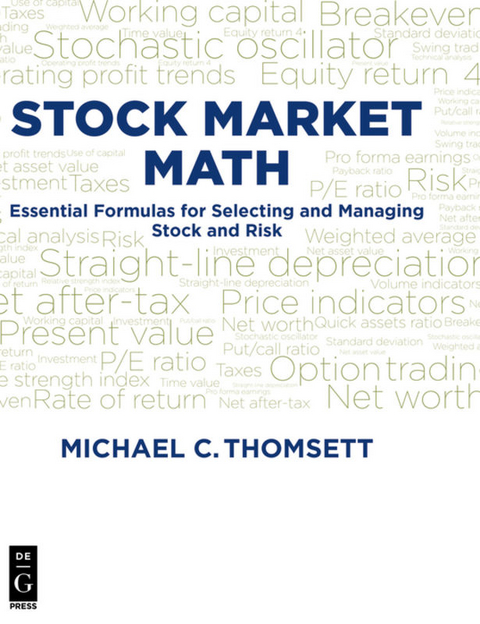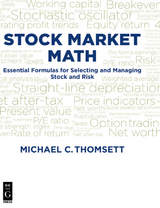Stock Market Math
Michael C. Thomsett, Business and investment writer
Chapter 1: Rates of Return on Investment: What Goes In, What Comes Out 1
Judging the Outcome – What Did You Expect? 2
The Basic Equation: Return on Cash Invested 4
Calculating Option Trading Returns 10
Taxes and Investment Return 13
Conclusion 17
Chapter 2: Returns on Capital: Putting Cash to Work 19
Calculating Returns from the Corporate View 19
Calculating Average Net Worth 22
Net Worth Versus Total Capitalization 24
Preferred Stock as Hybrid Capitalization 27
The Importance of “Use of Capital” 31
Conclusion 33
Chapter 3: Leverage and Risk Analysis: Maximizing Other People’s Money 35
Calculating the Cost of Money 35
Annualized Return 38
Leverage-Based Risk—the P/E Ratio as a Way to Quantify 40
Using Options as a Form of Leverage 44
Conclusion 48
Chapter 4: Long-Term Trends: Patience Rewarded 49
A Realistic View: Long-Term Returns and Annual Rates 50
Total Net Annualized Return 53
Carryover Losses and Net Return 56
Realistic Expectations: Inflation and Taxes 58
Compound Return Calculations 60
Other Cash Flow Trends 63
Return Formulas 65
Useful Return Shortcuts 70
Estimating the Value of Deposits over Time 72
Conclusion 76
Chapter 5: Core Earnings and Net Worth Adjustments: Making the Numbers
Real 77
The Problem with Today’s Accounting Rules 78
Flaws in the GAAP System – a Passive Approach to Reporting 80
Examples of Material Expenses 82
Balance Sheet Problems – Inaccurate Valuation 84
Recalculating the Key Ratios 85
Recalculating Net Worth 89
Finding Core Earnings – Comparative Analysis 92
Conclusion 93
Chapter 6: Fundamentals: Balance Sheet Tests You Need to Know 95
The Nature of Fundamental Analysis 96
Basics of the Balance Sheet 98
Working Capital Tests 101
Accounts Receivable Tests 105
Inventory Tests 108
Long-Term Asset Tests 110
Capitalization 112
Tangible and Total Book Value 116
Chapter 7: Fundamentals: Operating Statement Tests You Need to Know 121
The Basics of the Operating Statement 123
Revenue Trends 128
Earnings Trends 129
Revenue Compared to Direct Costs and Expenses 131
Conclusion 138
Chapter 8: Market Trend Calculations 139
Index Weighting 139
Breadth of the Market 143
Short Interest Ratio 146
New Highs and New Lows 148
Put/Call Ratio 151
Mutual Fund Ratios 152
Chapter 9: Price Indicators 159
The Basics of Technical Analysis 159
The Random Walk Hypothesis and the Efficient Market Theory 162
Basic Price Calculations 165
Chart Patterns and Interpretations 167
Technical Tests of Market Sentiment 171
Breadth of Trading 171
Chapter 10: Volume Indicators 175
Change in Volume 176
On Balance Volume (OBV) 178
Accumulation/Distribution (A/D) 180
Money Flow Index (MFI) 183
Large Block Ratio 186
Conclusion 187
Chapter 11: Momentum Oscillators and Moving Averages 189
Overview, Momentum Oscillators 189
Relative Strength Index (RSI) 192
Moving Average Convergence Divergence (MACD) 195
Stochastic Oscillator 197
Moving Averages 199
Bollinger Bands (BB) 201
Conclusion 204
Chapter 12: Combined Testing: Merging Price and Financial Tests 205
Effective Use of Combined Analysis 206
Valid Versus Invalid Forms of Testing 208
Identifying Important Combined Tests 209
Additional Price-Based Combined Tests 211
The Oddities of Hybrid Analysis 215
Appendix A Stock Market Formulas: Summarizing the Essentials 219
Appendix B: Excel Program Entries: Automating the Formulas 247
Index 267
| Erscheinungsdatum | 23.11.2017 |
|---|---|
| Zusatzinfo | 20 Illustrations, black and white; 30 Tables, black and white |
| Verlagsort | Boston |
| Sprache | englisch |
| Maße | 170 x 240 mm |
| Gewicht | 552 g |
| Themenwelt | Mathematik / Informatik ► Mathematik ► Angewandte Mathematik |
| Wirtschaft ► Allgemeines / Lexika | |
| Wirtschaft ► Betriebswirtschaft / Management ► Finanzierung | |
| Schlagworte | Chaikin • Compounding • Depreciation • Net Worth • Present Value • Price/earnings • Rate of growth • Rate of return • Rate of return, Rate of growth, ROI, Ratios, Chaik • Rate of return, Rate of growth, ROI, Ratios, Chaikin, Net worth, Stochastic, Present value, Depreciation, Compounding, Price/earnings • ratios • ROI • stochastic |
| ISBN-10 | 1-5015-1581-0 / 1501515810 |
| ISBN-13 | 978-1-5015-1581-1 / 9781501515811 |
| Zustand | Neuware |
| Haben Sie eine Frage zum Produkt? |
aus dem Bereich




